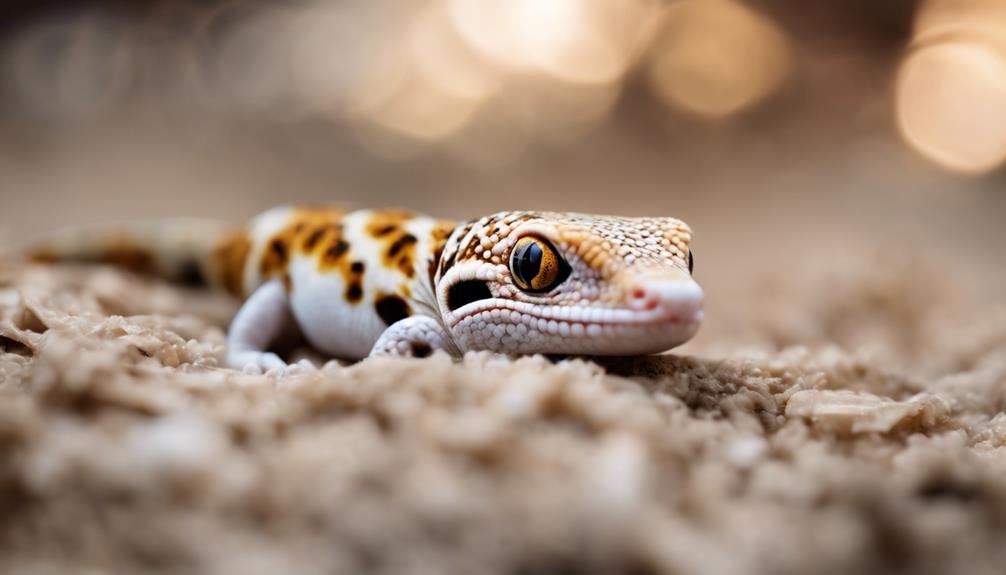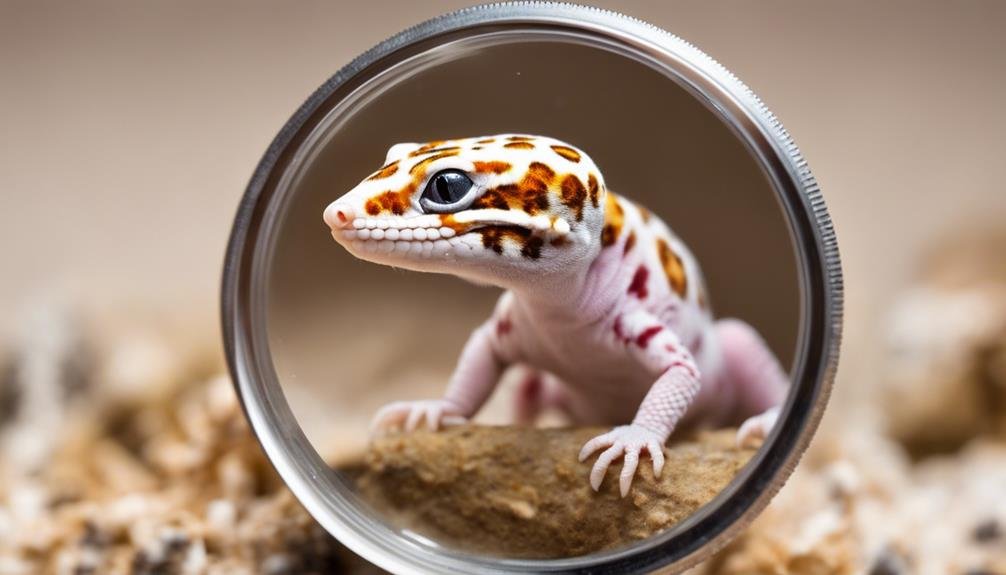If you’ve noticed your leopard gecko looking paler than usual without the signs of shedding, you might be dealing with more than just a simple delay in its natural cycle. This situation often points to deeper issues such as dehydration, infections, or even nutritional deficiencies, which shouldn’t be underestimated. Maintaining the right humidity levels, providing a balanced diet, and ensuring a stress-free habitat are essential to prevent these health problems. But what if you’re already doing all this, and there’s still no improvement? Exploring the potential causes and solutions becomes vital to restoring your pet’s vibrant colors and health.
Key Takeaways
- Paleness without shedding may indicate health issues like dehydration, nutritional deficiencies, or infections.
- Proper nutrition, including calcium, Vitamin D3, and protein, is essential for maintaining skin health.
- Environmental factors such as inadequate humidity or incorrect temperature can affect a leopard gecko’s paleness.
- Stress from improper habitat conditions or handling can also cause a leopard gecko to appear pale.
- Regular veterinary care is crucial for diagnosing and treating underlying causes of paleness in leopard geckos.
Shedding in Leopard Geckos
Shedding, or ecdysis, occurs every 2-4 weeks in leopard geckos, an essential process for their health and growth. During this time, you’ll notice your gecko might look paler or have opaque skin, signaling they’re about to start the shedding process. It’s a critical period when leopard geckos require extra care to ensure everything goes smoothly.
Proper nutrition is key to supporting a healthy shed. You must ensure your gecko is getting enough calcium, Vitamin D3, and protein. These nutrients are vital; without them, your gecko might face difficulties, such as retained shed or incomplete shedding. These issues aren’t just cosmetic; they can lead to significant health problems if not addressed.
You might observe increased hiding as your gecko prepares to shed. It’s their way of coping with the vulnerability during this period. Disturbances should be minimized to avoid stress, which can exacerbate shedding problems. If you notice parts of the skin not coming off, it’s a sign that something’s amiss, possibly linked to their environment or diet. Retained shed, especially around the toes or tail, can lead to circulation issues, making monitoring your gecko closely during and after the shedding process crucial.
Signs of Healthy Shedding
When your leopard gecko starts showing clear eyes and gradually lightening skin, it’s a sure sign they’re healthily shedding. Healthy shedding is essential for your gecko’s skin health and should happen every 2-4 weeks. Ensuring they have a moist hide is important to support this process, as it aids in easy shedding. Observing increased hiding behavior indicates that shedding is imminent, indicating that your pet is preparing for the process.
Proper nutrition plays a pivotal role in healthy shedding. A diet rich in calcium and Vitamin D3 supports the skin’s health, ensuring your leopard gecko can shed without issues. To give you a clearer picture, here’s a table detailing the signs of healthy shedding:
| Sign | Indicator | Why It’s Important |
|---|---|---|
| Clear Eyes | No cloudiness | Indicates overall health |
| Gradual Lightening | Skin becomes lighter | Shows skin is ready to shed |
| Moist Hide Use | Frequently using moist hide | Aids in easy shedding |
| Increased Hiding | More time spent hidden | Pre-shed behavior |
| Proper Nutrition | Balanced diet | Supports skin health |
Common Shedding Issues


Let’s explore the shedding process and how to identify problems that might affect your leopard gecko. Understanding what’s normal and what’s not can help you catch issues early on.
If your gecko’s skin looks pale but is not shedding, it’s time to pay closer attention to its health and behavior.
Shedding Process Explained
Understanding the shedding process is essential for leopard gecko owners, as issues can arise from stress, dietary deficiencies, and inadequate habitat conditions. Shedding every 2-4 weeks is vital for their growth and health. However, disruptions in this process due to various factors can lead to complications.
To guarantee a smooth shedding process and prevent common issues like skin paleness or metabolic bone disease, consider these points:
- Provide shallow water baths to help with difficult sheds.
- Prevent metabolic bone disease with proper nutrition, including calcium and Vitamin D3.
- Address dietary deficiencies that impact skin health and pigmentation.
- Ensure the habitat mimics its natural environment to reduce stress and promote regular shedding cycles.
Identifying Shedding Problems
Moving from how to support a healthy shedding cycle, it’s important to recognize signs that your leopard gecko may be facing shedding problems. Pale skin in leopard geckos often points to such issues, which may be due to inadequate humidity levels or an improper shedding environment. Monitoring shedding frequency and skin condition is key to identifying these problems early.
| Sign | Possible Cause |
|---|---|
| Pale skin, no visible shed | Inadequate humidity levels |
| Retained shed-on-the-skin | Improper shedding environment |
| Abnormal shedding patterns | Underlying health issues |
| Frequent, incomplete shedding | Skin condition concerns |
Consulting a vet is essential for addressing these shedding issues and ensuring your gecko’s well-being.
Nutrition and Shedding
You mightn’t realize it, but what you feed your leopard gecko is important in its shedding process.
Ensuring they get enough calcium, Vitamin D3, and protein is essential for skin health and shedding frequency.
If your gecko’s diet lacks these nutrients, it could be why they’re pale and struggling to shed properly.
Diet Impact on Shedding
A well-rounded diet, rich in calcium and Vitamin D3, guarantees your leopard gecko sheds properly and maintains healthy skin. When their diet lacks these key nutrients, you may notice shedding issues such as retained or incomplete shedding. Feeder insects like mealworms and crickets are indispensable in providing the nutrition your gecko needs to avoid these problems and maintain a vibrant, healthy coloration.
- Feeder insects offer essential nutrients that support healthy shedding.
- Shedding issues like retained shed are often linked to nutritional deficiencies.
- Nutritional deficiencies can lead to pale skin and incomplete shedding.
- Adjusting feeding habits can improve the shedding process and overall skin health.
Monitoring and adjusting your gecko’s diet is critical to prevent shedding complications and ensure their skin remains healthy.
Essential Nutrients for Health
To guarantee your leopard gecko’s health and proper shedding, it’s important to provide a balanced diet rich in calcium, Vitamin D3, and protein. Calcium isn’t just important for strong bones and muscle function; it is significant in supporting healthy shedding cycles. Without enough calcium, your gecko could face shedding issues, affecting their overall wellness.
Vitamin D3 is equally significant as it helps with the absorption and utilization of calcium, ensuring your gecko stays healthy and can shed properly. Conversely, protein is key for tissue repair, growth, and skin regeneration, especially during shedding.
Ensuring your leopard gecko gets these essential nutrients will help prevent shedding issues and promote overall wellness.
Environmental Factors


Understanding how environmental factors affect your leopard gecko’s health is essential, as inadequate conditions can lead to a pale appearance. Factors such as temperature, humidity levels, UVB exposure, and the choice of substrate play a significant role in maintaining their metabolism and overall well-being. When these environmental aspects aren’t properly managed, your gecko can look pale, indicating potential health issues.
Here are key environmental factors to take into account:
- Temperature: Incorrect temperature levels disrupt your gecko’s metabolism and coloration. Make sure their habitat has a proper thermal gradient.
- Humidity levels: Poor humidity control can lead to skin dryness and paleness. A balanced humidity level is important for their health.
- UVB exposure: Lack of adequate UVB light affects calcium absorption, leading to potential paleness from deficiencies.
- Substrate choices: Using the wrong substrate can cause stress, contributing to a pale appearance. Choose a substrate that mimics their natural environment to keep them comfortable.
Avoid environmental stressors like loud noises or excessive handling, as these can also lead to paleness by causing stress. Maintaining ideal conditions will help ensure your leopard gecko stays vibrant and healthy.
Health Check and Stress
While environmental factors play an important role in your leopard gecko’s health, it’s equally important to regularly monitor their well-being through health checks and understand the impact of stress on their appearance. Pale skin in these little reptiles can indicate several health issues, including dehydration, infections, or deficiencies. Scheduling regular vet care is important to pinpoint and tackle these underlying problems early on.
Stressors, such as improper habitat conditions or incorrect temperatures, can greatly contribute to your gecko’s pale appearance. Assessing and adjusting their environment to minimize these stress factors is necessary. Furthermore, behavioral changes like lethargy or a reduced appetite can accompany the paleness, signaling potential health issues that shouldn’t be ignored.
If you notice your leopard gecko turning pale and exhibiting these behavioral changes, it’s important to seek vet care promptly. Addressing dehydration or any other health concerns early can prevent more severe problems. Remember, attentive observation and prompt action can significantly affect your gecko’s health and vitality.
Conclusion
To sum up, if your leopard gecko appears pale but isn’t shedding, it’s important to evaluate its care. Check that it receives the right nutrition, ensures its habitat has the proper humidity, and keeps its environment stress-free.
Don’t underestimate the significance of regular health checks in detecting issues early. Remember, a healthy diet, adequate hydration, and the right living conditions are key to preventing shedding problems and maintaining your gecko’s vibrant color and overall well-being.
Can a Leopard Gecko’s Pale Coloration Be a Sign of Impending Shedding?
A leopard gecko’s pale coloration may indicate impending shedding. Although the leopard gecko’s shedding frequency varies, it typically sheds every 4-8 weeks. During this time, the gecko’s skin may appear dull and pale as it prepares to shed its old skin. Proper humidity and a moist hide can help the process.
FAQs
1. Is It Bad if a Leopard Gecko Doesn’t Shed?
Yes, if your leopard gecko doesn’t shed, it’s a sign something’s off. Shedding frequency is vital for their health. Low humidity levels, nutritional deficiencies, and environmental stressors can all disrupt the process.
2. What Do Leopard Geckos Look Like Before Shedding?
Before shedding, you’ll notice your leopard gecko’s color change; it will look paler or duller. There’s often a behavior shift, too—it might hide more or become less active. The skin texture appears different, getting more opaque.
3. How Do You Know if Your Leopard Gecko Is Healthy or Not?
To determine if your leopard gecko is healthy, look for bright eyes, a thick tail, and active behavior. These signs and regular defecation and consistent appetite are key indicators of good health.
4. Why Is My Leopard Gecko Not Eating and Pale?
If your leopard gecko’s not eating and looks pale, you’re likely dealing with temperature issues, an incorrect diet, stress factors, hydration concerns, or even a parasite infection. These problems can make your pet feel off, leading to a lack of appetite and a color change.
Supportive Article
Common Health Issues in Leopard Geckos


